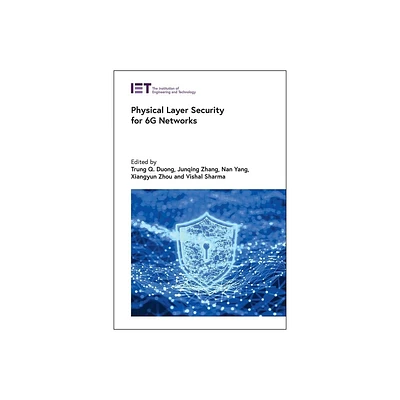Home
Physical Layer Security for 6G Networks
Loading Inventory...
Barnes and Noble
Physical Layer Security for 6G Networks
Current price: $175.00


Barnes and Noble
Physical Layer Security for 6G Networks
Current price: $175.00
Loading Inventory...
Size: OS
*Product Information may vary - to confirm product availability, pricing, and additional information please contact Barnes and Noble
6G networks are expected to provide one-microsecond latency communication with a billion devices competing for resources 1000 times faster than current standards. Increases in network speed, heterogeneity, virtualization, better radio requirements and adaptive communications will place new demands on physical layer security. Moreover, IoT, blockchain, and artificial intelligence are enabling technologies that require rapid data rates, raising a significant burden on the network's physical layer, requiring that security must be attained at a fast pace, and that the network must be resilient to accommodate sudden changes to the configurations or the load.
Physical layer (PHY) security solutions are needed that have the capacity to handle the new demands of 6G networks, whilst protecting those networks against risk factors such as interference, data spoofing, replay attacks, side-channel attacks, jamming, traffic analysis, and cyber-vandalism attacks. This comprehensive book addresses the PHY security challenges and proposes efficient and resilient physical layer security solutions for beyond 5G networks leading to 6G. Several topics have emerged that rely on PHY security in solving real-world network challenges such as ultra-dense networks, adaptive communication, distributed technology, and artificial intelligence.
Physical Layer Security for 6G Networks
helps readers understand the expectations of 6G's physical layer security in supporting pervasive and integrated communication networks, AI convergence and utility, and develop better sensing solutions, which go beyond cognitive radio, device-to-device or mm-wave communications.
Physical layer (PHY) security solutions are needed that have the capacity to handle the new demands of 6G networks, whilst protecting those networks against risk factors such as interference, data spoofing, replay attacks, side-channel attacks, jamming, traffic analysis, and cyber-vandalism attacks. This comprehensive book addresses the PHY security challenges and proposes efficient and resilient physical layer security solutions for beyond 5G networks leading to 6G. Several topics have emerged that rely on PHY security in solving real-world network challenges such as ultra-dense networks, adaptive communication, distributed technology, and artificial intelligence.
Physical Layer Security for 6G Networks
helps readers understand the expectations of 6G's physical layer security in supporting pervasive and integrated communication networks, AI convergence and utility, and develop better sensing solutions, which go beyond cognitive radio, device-to-device or mm-wave communications.


















